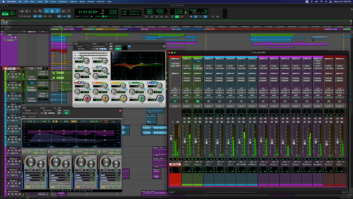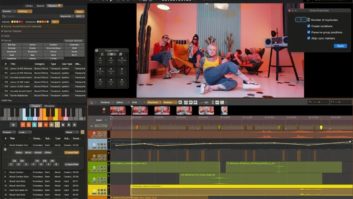Thunder Audio flies its newest flagship audio system, an L-Acoustics K2 rig, at Asheville NC’s 2,431-seat Thomas Wolfe Auditorium. With multiple musical acts gracing each stage, a constantly changing lineup of microphones, DIs and backline are juggled. Many acts carry their own or work with a microphone (often wireless) specialist or backline rental company, yet sound reinforcement providers are tasked with making those mics and their own gear all work together for maximum fidelity and unencumbered visuals. Here, we talk to a group of festival-experienced audio pros to detail what are truly supplied “must-haves” for acts hitting 2014’s festival stages.

MUST-HAVE 1: COMPREHENSIVE, VERSATILE SOUND CAPTURING TOOLS
Festivals, being artistically broader than an average two-to-three act tour, organically nurture the diversity of modern live sound, providing new challenges to engineers, their sound providers, mic specialists and more. As Gordon Reid—moderator of Moogfest 2014’s Synthesized Sounds & Voices panel series and, by trade, CEDAR Audio Ltd.’s managing director—illustrates, modern festivals ultimately require the widest range of input sources.
“There were 100 performers or so, and it would be fair to say that the vast majority of those conformed very strictly to the “electro” description of modern music,” reflects Reid. “But if you looked in the cracks of the schedule, you see the slightly quirkier, innovative things.”
“Good old fashioned standards include Shure Beta 98, Sennheiser 604, Shure KSM9 [pictured], Shure SM91, Sennheiser 904 and 609, and so on,” offers Thunder Audio’s Greg Snyder. MUST-HAVE 2: SONIC POWER AND FIDELITY

For electronic dance music (EDM) and other “microphone minimal” forms of live sound entertainment, gear needs notably stray from that of a more traditional rock backline. Of course, comprehensive mic packages aren’t needed for the EDM-based festival scene, but the input side of things isn’t the only big difference, shares Greg Snyder, business development manager for Thunder Audio, the primary sound vendor for Moogfest 2014.
“Today, manufacturers are building road-worthy ribbon mics and we’re getting that sound out there.”—Thunder Audio’s Greg Snyder, on the increased use of ribbon microphones on the road and in festivals. Pictured, a Thunder Audio favorite: the Cascade Fat Head. “Power is the key,” says Snyder. “In order to make those speakers do what their specs require, we need a significant amount of power. In older venues not generally built to host that kind of material such as Thomas Wolfe? Things happen in the room acoustically, in which we do throttle back the system as opposed to letting the system go for it.”

MUST-HAVE 3: RIDER-MATCHING MICROPHONES & WIRELESS SYSTEMS
A live sound firm such as Thunder Audio doesn’t supply backline (instruments and amps) for festivals, yet artist riders are regularly quite specific when it comes to input requirements.
“The real specialty items end up becoming wireless,” said Snyder. “Wireless heads are a great example: Shure KSM9 with UHF-R, Beta 58, and Sennheiser SKM Series systems are popular. Also, in-ear systems—Shure’s PSM 1000, Sennheiser G3s—those are the things we carry to all the festivals to create the backbone of the wireless systems, in-ears and handhelds.
“We’re also seeing the emergence, especially in the festival world, of wireless technology specialists, such as Professional Wireless Systems. They are often on-site with us, coordinating multiple stages of wireless. Not only do they help us, but they help the acts travelling with their equipment because each stage and performance is a ‘non-failure’ application.”
Make/models are generally a “greatest hits” of workhorse live microphones, while ribbon microphones are dramatically increasing in live sound popularity. “Good old-fashioned standards include Shure Beta 98, Sennheiser 604, Shure KSM9, Shure SM91, Sennheiser 904 and 609, and so on,” offers Snyder. “We’re also seeing a lot of the Shure ribbon mics now requested. That’s a great thing, because as Tony [Villarreal, owner of Thunder Audio] says, ‘There’s nothing like a great ribbon on a guitar’. The Royer brand is next in requests, followed by Cascade Fat Head ribbons.”
MUST-HAVE 4: INCREASED EFFICIENCY
Increased attention to all the gear involved has become a priority, from size/weight to how it is transported. “There’s still a lot of great tours out there, but how many of those tours have three, four or five extra trucks of lighting and sound? Truth is, these festivals have allowed many people to come to one spot to see many different bands; as a result, they helped in curbing the trucking costs, how acts look at touring schedules, how summers are spent, how much time is being put into production, and more,” said Snyder.







